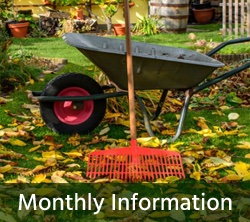
| Weather Averages September 1: High 82, Low 63 September 30: High 72, Low 53 Precipitation: 3.5 inches |
September Garden Calendar
Plant Clinics
Some plant clinics at Farmers Markets will operate until end of September. For schedules and locations visit the Plant Clinics page on this website.
Trees & Shrubs
Watering
If weather remains hot and dry, water deeply any trees or shrubs that have been planted within the past year.
Planting
September is a good time to plant shrubs and trees. If you are planting a containerized shrub or tree, carefully inspect the roots. Prune out circling roots or those that have started to grow upward in the pot. Remove as much of the planting medium from the roots as possible either by hand or using a hose. Tease out the roots so that they are pointing outward. Dig a hole that is at least twice as wide as the diameter of the root ball, and make sure the root flare of the trunk is at or a little above the final level of the backfilled soil. Do not amend the backfill soil. Water it well and continue regular watering throughout the fall.
Fertilizing
Do not fertilize your trees and shrubs now. This can produce tender growth that is not hardy during winter cold. For deciduous trees, wait until they go into dormancy before fertilizing.
Pruning
Prune all dead, damaged or diseased branches any time of the year. Other pruning of trees and shrubs should wait until cooler weather in November and beyond.
Lawn
Mowing
Three inches or higher is a good cutting height for Kentucky bluegrass, perennial ryegrass and tall fescue.Mow zoysiagrass and bermudagrass to 1 to 2 inches.Use a mulching mower, and leave the clippings on the lawn to return nutrients to the soil.
Cool Season Grasses
September is great time to plant grass. See our feature Lawn Renovation, Part 1: Making Choices and Lawn Renovation, Part 2: Planting Grass.September is the beginning of lawn fertilization season. For an entire year the recommended amount of fertilizer is about 2 pounds of nitrogen per 1000 square feet of lawn. (Note that the turfgrass experts have lowered this total amount in recent years from 3 pounds to 2 based on testing. Some manufacturers of fertilizer have responded by making package weights smaller.) Typically one should make three applications of 0.7 pound of nitrogen per 1000 square feet in September and October, about 3 weeks apart. Alternatively, one could make two of these applications in the fall and one in late May of the following year.
In late September after the temperatures have dipped into the 70s and everything is actively growing, you may begin to use selective broadleaf herbicides. Do not apply broadleaf herbicides to newly seeded grass until you have mowed it at least twice. To be safe, check the label of the herbicide for instructions on newly seeded lawns.
Warm Season Grasses
(zoysiagrass, bermudagrass)
Enjoy your lawn.
Vegetable Garden
It’s time to clean up. Good garden sanitation is important for prevention of disease and insect problems next year. Diseased vegetation should be put in the trash, not in your compost bin.
Keep your basil producing through the fall by pinching off the flowers.
Harvest garlic when the tops die down. Keep the bulbs for 4 to 6 weeks in a warm, shady, well ventilated place to cure them for long-term storage. This is a good month to plant new garlic bulbs for next year.
Fruits
Orchard sanitation is particularly important this time of year to prevent problems next year. Rake up and dispose of fallen fruit and leaves. Prune dead limbs and branches.
If you don’t have fruit trees now but want to plant a small orchard, September is a good month to plan. Some things to think about are the site for your new orchard and the types of trees to plant. Testing and preparing soil and obtaining trees could occur in October. Planting time starts a month after the first killing frost of the fall and extends until a month before bloom time in the spring.
Unlike other fruit, pears do not ripen well on the tree. Pick pears when they are hard ripe, and store them at room temperature. When the stem end of the pear ripens, it becomes a little soft. Refrigerate pears after they ripen, not before.
Mummified grapes on the vine are a sure sign of black rot. Remove and dispose of them promptly to prevent the spread of the disease. It is likely you will need to spray a preventive fungicide on the plants next season.
Fall-bearing strawberries should be harvested as soon as they ripen to prevent insect and disease problems.
Two-year-old canes of raspberry and blackberry plants should be removed to prevent overwintering of disease.
Refrences
References
A Guide to Successful Pruning, Shrub Pruning Calendar, VCE Publication
A Guide to Successful Pruning, Deciduous Tree Pruning Calendar, VCE Publication
A Guide to Successful Pruning, Evergreen Tree Pruning Calendar, VCE Publication
Maintenance Calendar for Cool-Season Turfgrasses in Virginia, VCE Publication
Mowing To Recycle Grass Clippings: Let the Clips Fall Where They May, VCE Publication 430-402
Maintenance Calendar for Warm-Season Lawns in Virginia, VCE Publication 439-522
Spring and Summer Lawn Management Considerations for Cool-Season Turfgrasses, VCE Publication 430-532
Vegetable Planting Guide and Recommended Planting Dates, VCE Publication 426-331
Tree Fruit in the Home Garden, VCE Publication 426-841
Tomato Questions, Texas A&M Extension Publication
September Tips: Herbs, VCE Publication
September Tips: Fruits and Nuts, VCE Publication